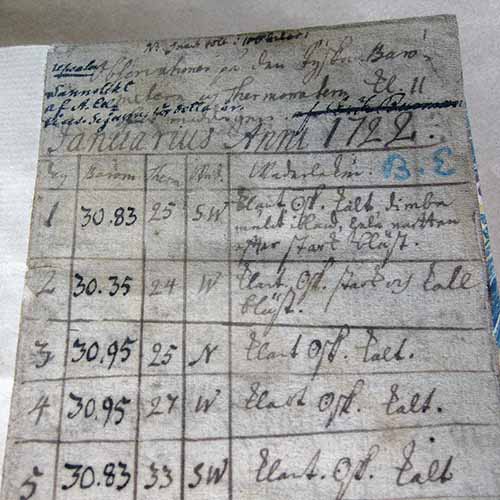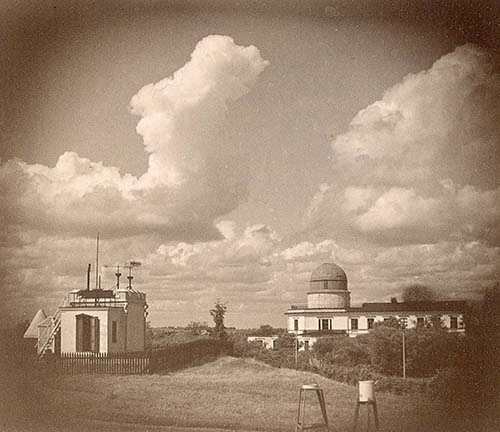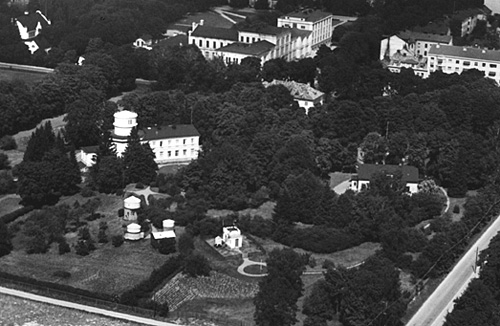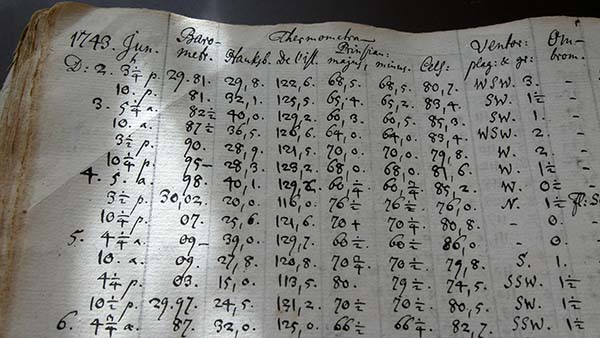The long climate record of Uppsala
The first meteorological journal from Uppsala in 1722 (click to view enlargement of the whole page). University library.
The long climate record of Uppsala
1. Introduction
Instrumental records of the climate in Europe are available since the time of the invention of the meteorological instruments in the middle of the 17th century. These records are detailed indicators of the past climate with a temporal resolution down to the daily values, although commonly only the monthly averages are considered in old data. Very few records, however, are complete for the whole time period since before the 1750s.
Swedish archives are rich in meteorological observation journals from the time before the 'modern' instrumental epoch since around 1860. The most well-known Swedish meteorological record is that of monthly air temperatures in Stockholm, beginning in 1756, but the longest record is that from Uppsala beginning in 1722. As early as in 1778, the temperature series from Stockholm and Uppsala have been used in a study of the climatic changes A nice graphical presentation of the combined Uppsala and Stockholm temperature series has also recently been published in the National Atlas of Sweden (1995). The two long temperature series provide important documentary evidence for the variations of the air temperature that have occurred in southern Sweden during the past ~250 years.
2. Station history
The earliest organised meteorological observations in Sweden were initiated around 1720 by the Society of Science in Uppsala, and Professor Erik Burman started the observations in Uppsala. He was assisted by the young Anders Celsius, who took over the responsibility in 1729. Other observational sites were also initiated during the 1720s and 1730s. Among them were Risinge and Linköping in Östergötland and Bettna in Södermanland. The oldest still available journal from Uppsala is from the year 1722, but before 1773 there are some periods with missing data. Until August 1853 the observations were made at the old astronomical observatory in the centre of Uppsala ('Celsiushuset'), which was then a small town (8 000 inh. in 1860). In September 1853, the observation site was moved to a then newly built astronomical observatory. This place was then situated in open fields outside the town, about 1 km north-west of the old place. Further changes of the thermometer site have taken place in October 1865, June 1952 and August 1959. All places since 1853 lie within a few hundred metres from each other, but the area has become surrounded by buildings as Uppsala has increased its population to around 150 000 inhabitants. From August 1959 the measurements were made at the Department of Meteorology at Uppsala University (5951'N, 1737'E, 13 m a.s.l.), and in January 1998 the measurement site was moved about 1.4 km further south to 'Geocentrum' (59°50.85'N, 17°38.10'E, 25 m a.s.l.) as the old Department of Meteorology joined the new Department of Earth Sciences.
The instrument house, built in 1864, in front of the astronomical observatory. From 1865 hourly observations were carried out in this house, engaging students in the ambitious work. Both buildings still exist, the former abandoned, the latter now housing other departments within the university. The site, initially ideally suited for its purpose in the outskirts of the small town, in time became less apt due to the growing trees, today forming the Observatory Park (click to view enlargement). The Hildebrandsson collection, University library. To view the site of today, click here.
Aerial photo of the observatory park in 1935. To the left of the instrument house numerous astronomical buildings can be seen. Photo Oscar Bladh, courtesy City library, the Uppsala collection (photo L 523-1935). Click on image to view the uncropped photo.
Before 1751 a variety of thermometer scales were used, among them of course Celsius' own thermometer. One was already during the 1740s aware of the uncertainties caused by the various thermometer scales, whose fix points sometimes were poorly determined. As a consequence of this, the observations in Uppsala were often made simultaneously with several thermometers (Celsius, de l'Isle, Hawksbee, Réaumur, Fahrenheit). This makes it possible today to calibrate the poorly determined, or sometimes even unknown, thermometer scales against the Celsius thermometer. Fortunately, there are always some overlapping periods with all of the thermometers used during 1739-1750, making the calibrations to C rather straightforward back to 1739. The earlier observations have been more difficult to handle. Although two Hawksbee thermometers were used during the late 1720s, none of them was the same as the one used in the 1740s. (The Hawksbee thermometers were among the least accurate of the thermometers used in the early 18th century. It has been documented in Uppsala that two Hawksbee thermometers used there differed by 12 degrees). Thus it has not been possible to calibrate the earliest data in the same simple manner as was done for the period from 1739 onwards. Instead, the thermometers used in Uppsala during 1722-1732 have been calibrated using data from Risinge in Östergötland, one of the other observational sites that were initiated by the Society of Science in Uppsala. The observations at Risinge, 170 km southwest of Uppsala, started in January 1730 and continued until January 1741. The thermometer used at Risinge is of unknown type, but it has been calibrated against the observations in Uppsala from January 1739 to January 1741. Using the calibration for the period 1739-1741 to convert the Risinge observations to degrees Celsius (as representative for the conditions in Uppsala), we may again use the contemporary data at Risinge and Uppsala from January 1730 to May 1732 to get a calibration of the Hawksbee thermometer used in Uppsala during this period. As was the case during the 1740s, the temperature readings during the 1720s were often made using several thermometers simultaneously. Having got the calibration of the old Hawksbee thermometer in Uppsala through the Risinge thermometer, it is thus again rather straightforward to calibrate the five other thermometers used in Uppsala during 1722-1732. Furthermore, missing data in the Uppsala series have been interpolated using data from Risinge for the period 1732 to 1738, from Bettna for the missing months in 1742 and 1745 and data from Linköping for the period from May 1750 to August 1751. Finally, data from Stockholm have been used for interpolation of missing data during the 1760s and 1770s. Thus, we have obtained a complete climate record for Uppsala since 1722.
The meteorological journal the day the Celsius thermometer is being introduced, June 2 1743 (old calendar), with five thermometers in parallell use, Celsius being the last (click to view enlargement). University library.
Before 1832 the observations were not made at fixed hours, but were mostly taken two to four times per day at varying hours. One of the observations was predominantly made at the time of sunrise, when the temperature is commonly at its minimum. Another observation was usually made in the early afternoon when the temperature often reaches its maximum of the day. This means that, on the average, monthly mean temperatures determined simply by taking the average of the temperature readings will be rather accurate. However, in order to further increase the accuracy of the average temperatures, account has been taken to the given observational hours and the observed diurnal temperature cycle:
Td = 1/n (T1+D1 + T2+D2 + ... + Tn+Dn)
where Td is the daily mean temperature, T1, T2, ..., Tn denote the recorded temperatures and D1, D2, ..., Dn denote the mean deviation from the daily mean temperature at the actual observation hour as determined from modern data (1959-84). The number of terms, n, in the sum is determined by the number of observations made each day. The monthly mean temperature, tm, has been obtained as the average of all daily means. This technique has been used to determine monthly mean temperatures back to 1739. For the earlier data, both from Uppsala and from Risinge, the thermometers were often not well enough ventilated. As a consequence, the daily temperature variation became too small, and there was also some delay introduced in the course of temperature during the day. These two effects have been accounted for when determining the average temperatures for the period 1722-1738. This was achieved by comparing the early 18th century observations on a monthly basis with the daily temperature variations during 1961-90. Best agreement was found using monthly factors, which were multiplied with the deviations (1 etc.), varying between 1.05 and 1.9 for the Risinge data, and between 2.1 and 5.0 for the Uppsala data. Applying these factors to the early observations, present day daily temperature amplitudes were on the average reproduced also in these data, and the monthly averages could be determined taking the actual observational times into account. Furthermore, calculations of the old daily mean temperatures have been made separately for each thermometer that was used and the final monthly means have been obtained as an average.
From 1832 to 1862, observations were made at 7, 14 and 21, and the following formula has been used to determine the monthly average temperature:
Tm = 1/4 (T7 + T14 + 2T21)
where T7, T14 and T21 denote the monthly averages at the respective hours. In 1863 the morning observation was changed to 8 a.m., and for the period to May 1865 the monthly averages have been determined with the formula:
Tm = 1/7 (T8 + T14 + 5T21)
Since June 1865, the observations have been made every hour, 24 times per day, and the mean temperatures have been based on arithmetic averages of these hourly observations. Automatic recording instruments, placed in a small observational screen, were in use from August 1868 to 1 June 1952. After that, recording instruments were placed in Stevenson screens. From 1985 the data were sampled with a computer based SMHI-type automatic weather station. As the observational site was moved to 'Geocentrum' in January 1998, a new Campbell automatic weather station replaced the old one.
Hans Bergström, Department of Earth Sciences - Meteorology, Uppsala University





